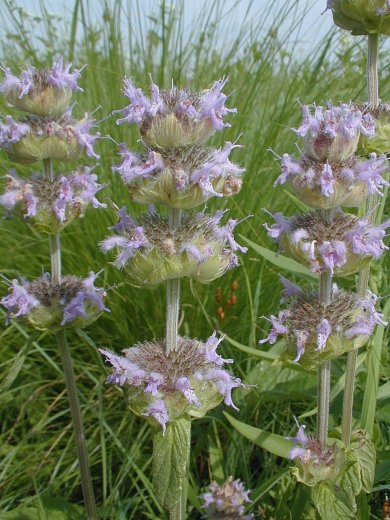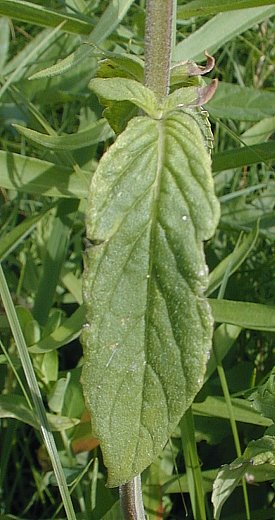Description: This is an unbranched perennial plant about 1-2' tall. Side stems may develop from upper leaf axils if the central stem is damaged. This stout central stem is 4-angled and it is covered with short white hairs that are usually appressed. The opposite leaves are up to 3½" long and 1½" across. They are broadly oblong to lanceolate in shape, and have smooth, slightly ciliate margins. The lower leaves have short stout petioles, while the upper leaves are sessile. They have deep pinnate venation and are covered with a white pubescence. The upper half of the central stem is perforated by whorled clusters of flowers. Each cluster of flowers is about 2-3" across and in the shape of a flattened sphere, with the flowers arranged in circular rows. The flowers are white, light pink, or lavender, and individually slightly less than ½" long. There are two prominent lips, with small purple spots on the lower one, and fine hairs in the back. The blooming period occurs during early summer and lasts about a month. Neither the flowers nor the leaves have a noticeable scent. The root system consists of a taproot, which forms offshoots occasionally by means of short rhizomes. The seeds are quite small, and distributed by the wind to some extent.

Cultivation:
The
preference is full or partial sun, and mesic to dry conditions. The
soil can contain significant amounts of loam, clay, or gravel;
limestone and a high pH are tolerated. The foliage can be affected by
the usual diseases that attack other mints, and often appear rather
ragged by mid-summer. This plant has greater tolerance to drought than
most other members of Mint family.
Range & Habitat:
Downy Wood Mint occurs occasionally in scattered counties in Illinois –
it has been reported most often from counties in the NE and
west-central areas of the state (see Distribution
Map). This plant is native to Illinois. Habitats include
mesic to dry black soil prairies,
dolomite prairies, thickets, savannas, limestone bluffs, and
limestone glades.
Faunal Associations:
The flowers attract long-tongued and short-tongued bees, bee flies,
Syrphid flies, butterflies, and skippers. The numerous bee visitors
include honeybees, bumblebees, Anthophorine bees, little carpenter
bees, leaf-cutting bees, Halictine bees, masked bees, and others. The
small seeds are unlikely to be of much interest to birds, nor is the
foliage an attractive source of food to mammalian herbivores.

Photographic
Location:
The photographs were taken at Loda Cemetery Prairie in Iroquois County,
Illinois.
Comments:
This plant can be easily confused with some of the weedier Eurasian
mints, but should not be destroyed because it is not particularly
common in Illinois. Notwithstanding its common name, Downy Wood Mint
occurs in open areas more often than woodlands, unlike other members of
the genus, such as Blephilia hirsuta (Hairy Wood
Mint). The stems of the latter species have long spreading hairs, while
the stems of Downy Wood Mint usually have short appressed hairs. Other
common names for Blephilia ciliata are 'Ohio
Horsemint' and 'Pagoda Plant.'